ANURADHAPURA
Anuradhapura, the ancient Kings ‘ sacred city, is full of history and mystery. Founded in the 6th century BC and venerated by the world’s Buddhists, it is now a UNESCO World Heritage Site at the core of the famous ‘ cultural triangle ‘ of Sri Lanka. As Sri Lanka’s old capital, Anuradhapura was not only the island’s early buddhist cradle, but also the driving force behind cultural and scientific developments aimed at improving the health and well-being of all those who resided there.
It also includes the sacred Bo Tree 2,000-year-old. According to legend, a cutting from the tree in Bodh Gaya, India, under which Buddha himself achieved enlightenment, created this much-venerated symbol. Anuradhapura's ancient metropolis is one of the oldest continuously inhabited cities in the world, surrounded by monasteries occupying an area of more than sixteen square miles. It has also been one of the most stable centers of political power and urban life in South Asia for many decades.
Today, in the center of this iconic place, the town ruins are maintained with excellent care and attention to ancient and historical details. Most of them consist of three building classes: stupas, monastic houses, and ponds. Stupas are stone-built structures that contain Buddhist relics, including Buddhist monks ' ashes, as well as treasures and valuables. They conform to seven classic forms, vary in size from a few feet to a circumference of more than 1,100 ft (340 m), and are discovered throughout Anuradhapura. One of the most famous of the monastic structures is the Lovamahapaya, or Brazen Palace. Originally 150 feet elevated and backed by 1,600 pillars of stone, its roof was coated with bronze-copper plates. There were 1,000 rooms in the building, and corals and precious stones were covered.
Ponds are discovered everywhere, or stone-built pools used for bathing and drinking water. They include the Kalu Diya Pokuna, or Natural Black Water Pond, and are thought to have been component of an impressive network of rivers and irrigation channels. They are believed to have also created beautiful private formal gardens where the kings would relax and entertain. Sri Lanka possesses, according to historical records, the biggest quantity of Buddha's relics that have so far been uncovered from any country. Due to the biggest amount of relics to be discovered there, Anuradhapura is considered the most important religious place.
ATTRACTIONS IN ANURADHAPURA
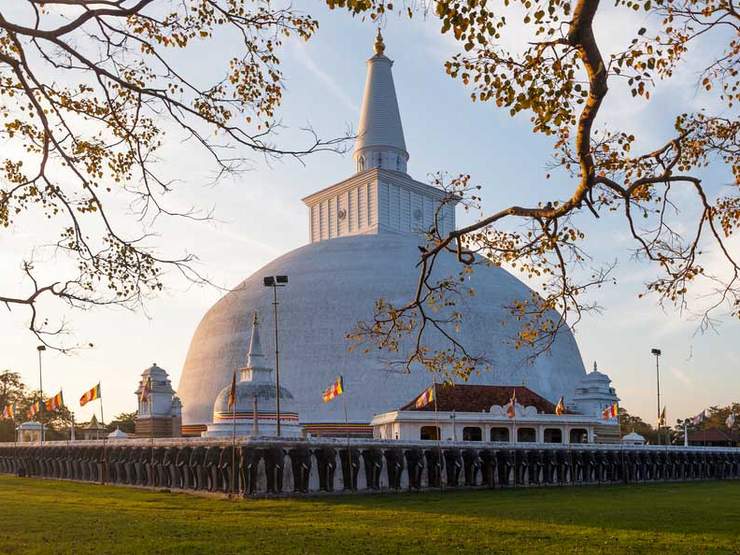
RUWANWELISEYA DAGABA
Ruwanweliseya, this tallest and probably the most wonderful stupa of Anuradhapura, is revered by the world’s Buddhists and considered by both believers and non-believers as an architectural wonder. Built in 140 BC by Gamini Abhaya, who governed Sri Lanka in fight after defeating Chola King Elara, this most iconic stupa in Anuradhapura, history was constructed to stringent norms and attention to detail.
According to a contemporary report, ‘fine clay was brought from the Himalayas, bricks laid over the clay, rough plaster over the bricks, quartz over the plaster, a network of iron over the quartz, fragrant clay over the network of iron, white stones over the fragrant clay, rock-crystal over the white stones, and slabs of stones over the rock-crystal.
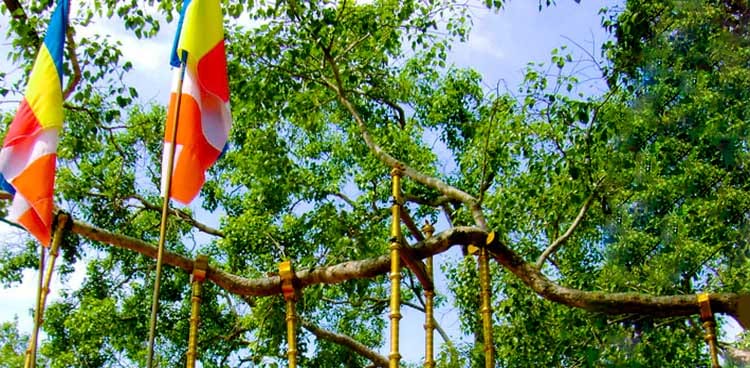
JAYA SRI MAHA BODHI
Jaya Sri Maha Bodhi in the Anuradhapura Mahamewna Gardens is a sacred fig tree. It is said to be the southern branch of the historic Sri Maha Bodhi at Buddha Gaya in India under which Lord Buddha’s Enlightenment was achieved. It was planted in 288 BC and with a known planting date it is the oldest living human-planted tree in the world.
Today, it is one of the Buddhist's most sacred relics in Sri Lanka and is respected throughout the world by Buddhists. The other fig trees surrounding the sacred tree safeguard it against storms and animals like monkeys, bats, etc.
The government prohibited all construction within 500 meters of the tree in April 2014. Only construction will be permitted which will obviously not harm the tree.
Sangamitta Theri, Emperor Asoka's daughter and founder of an order of Buddhist nuns in Sri Lanka brought it to Sri Lanka in the 3rd century BC. King Devanampiya Tissa planted it in 288 BC on a high terrace about 6.5 m (21.3 feet) above ground in the Anuradhapura Mahamevnawa Park.
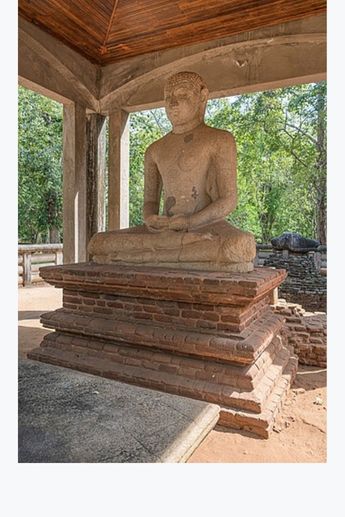
SAMADHI STATUE
The Samadhi Statue is a statue located in Anuradhapura, at Mahamevnawa Park. In the place of the Dhyana Mudra, the place of meditation connected with his first Enlightenment, the Buddha is portrayed. Whether the Buddha’s Enlightenment was the technically called samadhi experience, or some other phenomenon, may rely on the believer’s philosophical loyalty. The Buddha sits cross-legged in the Dhyana Mudra with his upturned palms positioned on his lap one over the other.
This stance is widely recognized throughout the Buddhist globe, and therefore this statue is one of Buddhist sculpture's most typical parts. It is not to be confused with the very comparable "Earth-Touching Mudra," which portrays the easy action taken by the Buddha to fend off the illusions projected by Mara, who was desperate to avoid the Buddha from realizing that his predictions, Mara's, and with them the whole world, are an illusion. This statue is 8 feet tall and granite sculpted.
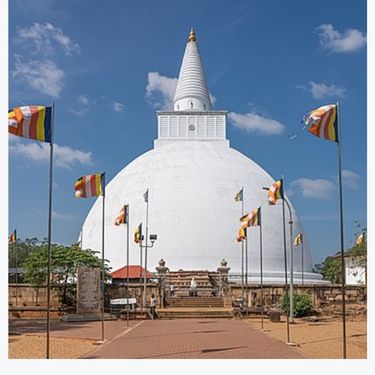
MIRISAWETI STUPA
The Mirisaweti Stupa is located in the ancient town of Anuradhapura, Sri Lanka. After defeating King Elara, King Dutugamunu (161 BC to 137 BC) constructed the Mirisaveti Stupa. He had gone to Tissa Wewa for a bath leaving the sceptre after putting the Buddha relics in the sceptre. He returned to the place where the sceptre was placed after the bath, and it’s said he couldn’t move it.
In the location where the sceptre stood, the stupa was constructed. It's also said that he remembered that without offering it to the sangha, he partook a chilly curry. He built the Mirisavetiya Dagaba to punish himself. This property has an area of approximately 50 acres (20 ha). Although this has been renovated by King Kasyapa I and Kasyapa V, it has been dilapidated from time to time.
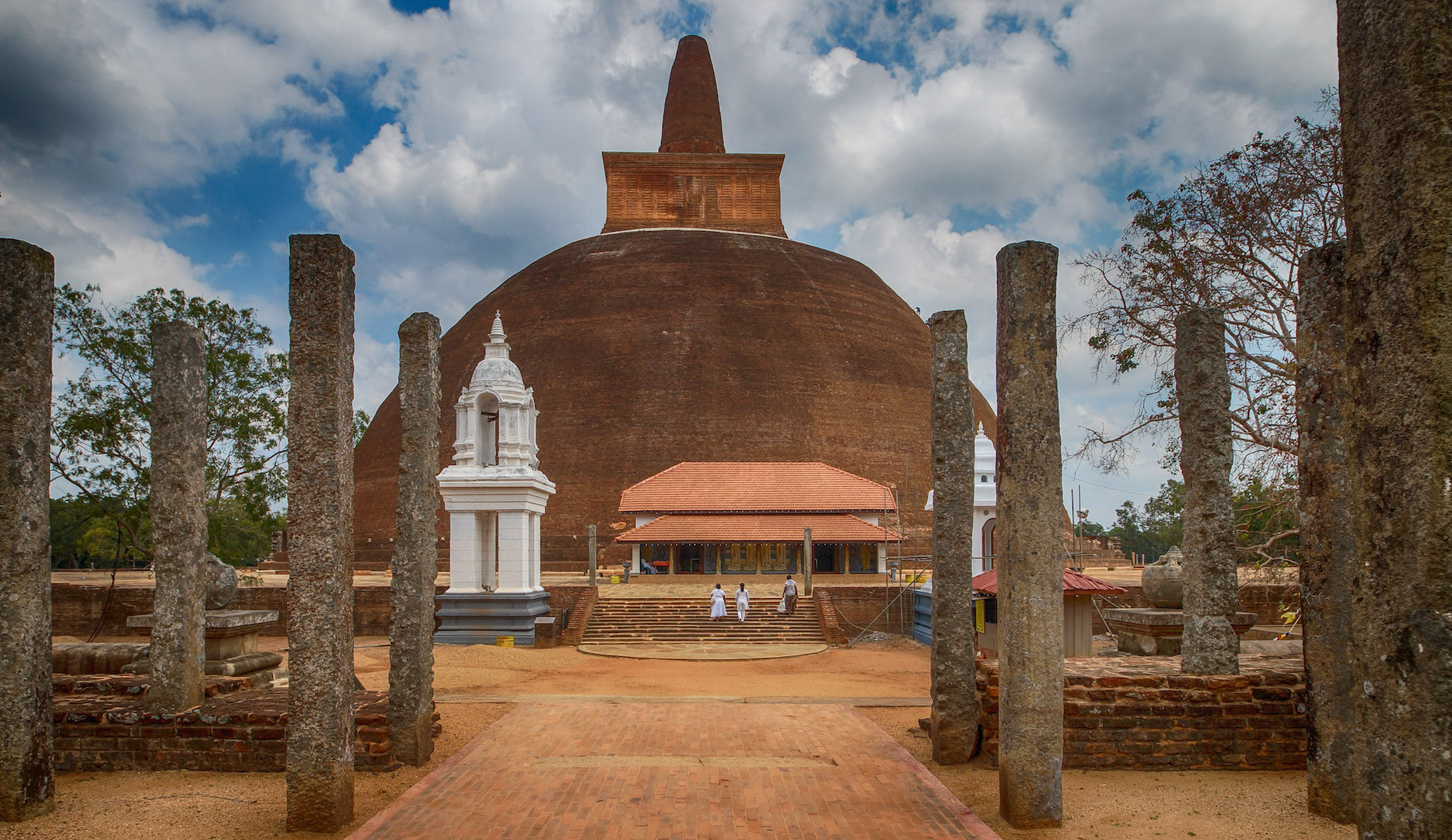
ABHAYAGIRI VIHARA
Abhayagiri Vihara was located in Anuradhapura, Sri Lanka, a significant monastery site of Mahayana, Theravada and Vajrayana Buddhism. It is one of the world’s largest ruins and one of the nation’s most sacred pilgrimage Buddhist towns. Historically it was both a huge monastic center and a royal capital, with splendid monasteries rising to many tales, covered with golden bronze or burnt clay tiles covered in brilliant colors
To the south of the town was "Abhayagiri," one of seventeen such religious units in Anuradhapura and the biggest of its five main viharas, surrounded by large walls and containing elaborate bathing pools, sculpted balustrades and moonstones. One of the complex's focal points is an ancient stupa, the Dagaba Abhayagiri. Abhayagiri Vihara was a Northern Monastery seat around the humped dagaba, or Uttara Vihara and the island's initial custodian of the Tooth relic.
The word "Abhayagiri Vihara" implies not only a complex of monastic structures, but also a brotherhood of Buddhist monks, or Sangha, who maintain their own historical documents, traditions and lifestyles. Founded in the 2nd century BC, by the 1st century AD it had become an international institution, attracting scientists from all over the globe and embracing all shades of Buddhist philosophy. Its impact can be traced through branches formed elsewhere to other areas of the globe. Thus, the Abhayagiri Vihara developed in the ancient Sri Lankan capital of Anuradhapura as a great institution vis-à-vis the Mahavihara and the Jetavana Buddhist monastic sects.
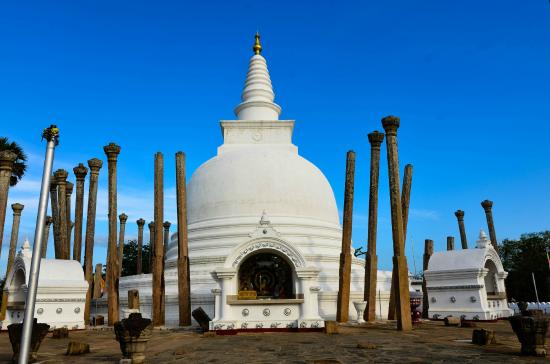
THUPARAMAYA
Thuparamaya is Sri Lanka’s first Buddhist temple. The Thuparamaya Stupa is the oldest Dagoba to be built on the island in the sacred region of Mahamewna Park, dating back to King Devanampiya Tissa’s reign (247-207 BC). The temple was officially recognized as an archeological site in Sri Lanka by the government.
Mahinda Thera, an envoy sent by King Ashoka himself, brought the Buddhism of Theravada and Chaitya to Sri Lanka as well. King Devanampiya Tissa built Thuparamaya at his request in which he consecrated the Buddha's right collar-bone. It is regarded to be the first dagaba to be constructed in Sri Lanka after Buddhism was introduced and also the oldest monument to be chronicled in its development. The name Thuparamaya comes from a housing complex for monks called "stupa" and "aramaya."

ISURUMUNIYA ROCK TEMPLE
Isurumuniya is a Buddhist temple located close the Tissa Wewa (Tisa tank) in Anuradhapura, Sri Lanka. This Vihara has four sculptures of unique concern. They are the lovers of Isurumuniya, the Elephant Pond and the Royal Family.
This is where Pulasthi Rishi lived and where King Ravana was born. This site has written about 5000 years of history. This location is also one of the world's 3 star gates. King Devanampiya Tissa (307 BC to 267 BC) ruled the temple in Anuradhapura's ancient capital of Sri Lanka. Isurumuniya was constructed for them to live after 500 high caste kids were ordained.
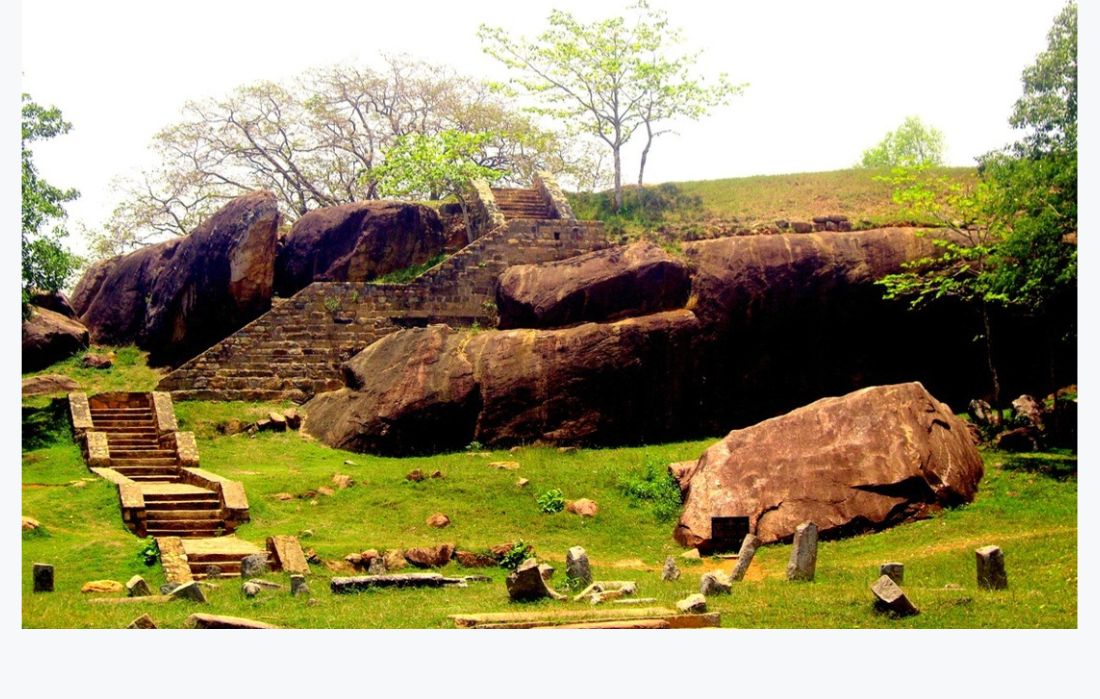
VESSAGIRIYA
Vessagiri is an ancient Buddhist forest monastery that is part of the ruins of Anuradhapura, one of Sri Lanka’s ancient capitals. It is located among the boulders about half a mile south of Isurumuniya. Started in King Devanampiya Tissa’s reign (mid-3rd century BC), during King Kasyapa’s reign (473-491 AD) the site was extended to become home to about five hundred monks
. The Vessagiri monks lived in rock shelters built from local materials by quarrying. The visitor of today sees only the bare stones-and not all of them, as much of the rock was later carted away and reused elsewhere. But the dwellings were completed with wood and other perishable materials when they were occupied.
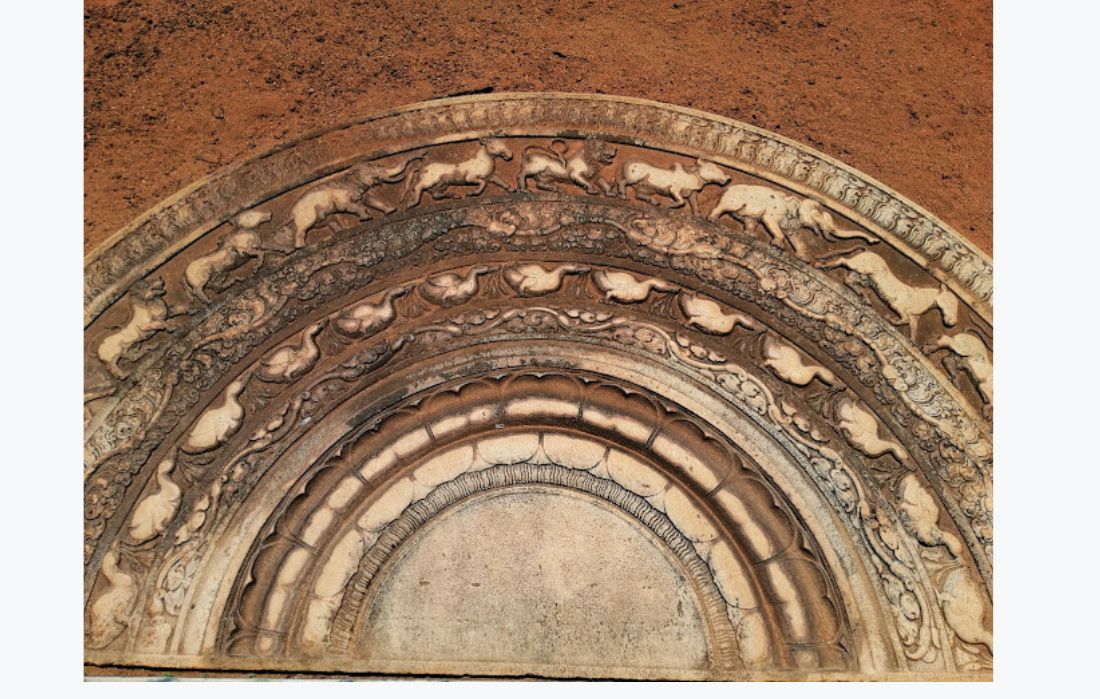
SANDAKADA PAHANA
Sandakada pahana, also known as Moon-stone, is a distinctive characteristic of ancient Sri Lanka’s Sinhalese architecture. It is an elaborately sculpted semi-circular slab of stone, generally at the bottom of staircases and entrances. The sandakada pahana first seen in the latter phase of the Anuradhapura period developed through the era of Polonnaruwa, Gampola and Kandy. According to scholars, in Buddhism, the sandakada pahana symbolizes the cycle of Sansara.

GUARDSTONE (MURAGALA)
Guardstones, discovered at the entrances of all the historic houses and palaces of Anuradhapura, were originally meant to encourage mystery, awe and respect. They also symbolized fertility, wealth, and prosperity, and developed from simple stone slabs to extremely decorated — and somewhat intimidating— stone bastions, excellent instances of which are those discovered in King Wijayabahu’s palace in Anuradhapura.
They feature two Bahiravas, Kuvera's servants, the god of riches, vital embellishments including Cobra depictions, a sacred symbol best seen on guardstones in Minneriya and Mihintale in Sri Lanka's Buddhist culture. The guardstones, together with a heavily decorated flight of stairs and elaborately sculpted moonstones, are essential to Anuradhapura's history and are considered by early Sri Lankan artists as some of the finest sculptures ever created.
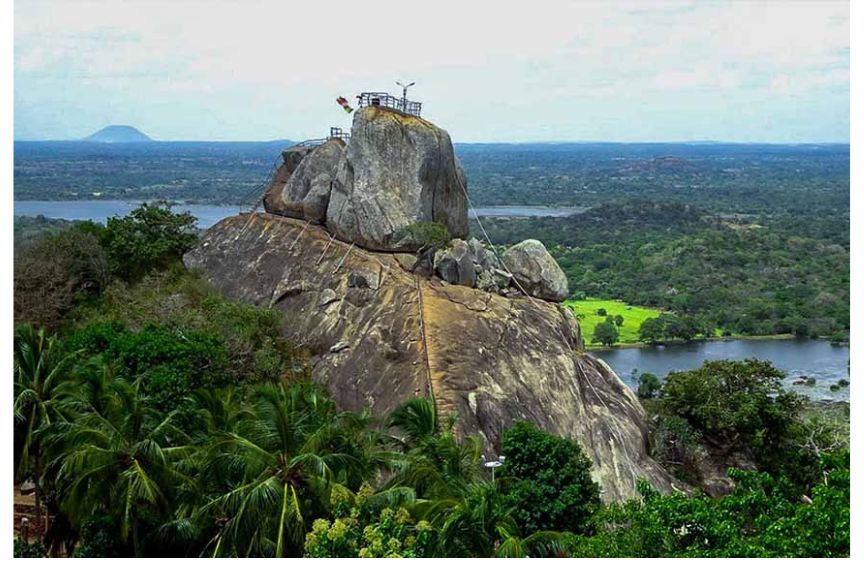
MIHINTALE TEMPLE
Historically recorded as the birthplace of Buddhism in Sri Lanka, Mihintale is commonly believed by Sri Lankans to be the meeting place of the Buddhist monk Mahinda, son of Emperor Ashoka of India, and King Devanampiyatissa in the 3rd century BC.
Mahinda preached the doctrine of Lord Buddha to the King and his people on the full moon day in June (Poson), which remains a special holiday in Sri Lanka and also led to all Poya (full moon) days becoming holy days for Sri Lankan Buddhists – tourists should note that meat and alcohol are not served in the island on Poya days. This meeting was the beginning of Buddhism in Sri Lanka, which quickly became a core part of Sinhalese culture, something that is evident in all the island’s ancient cultural sites.
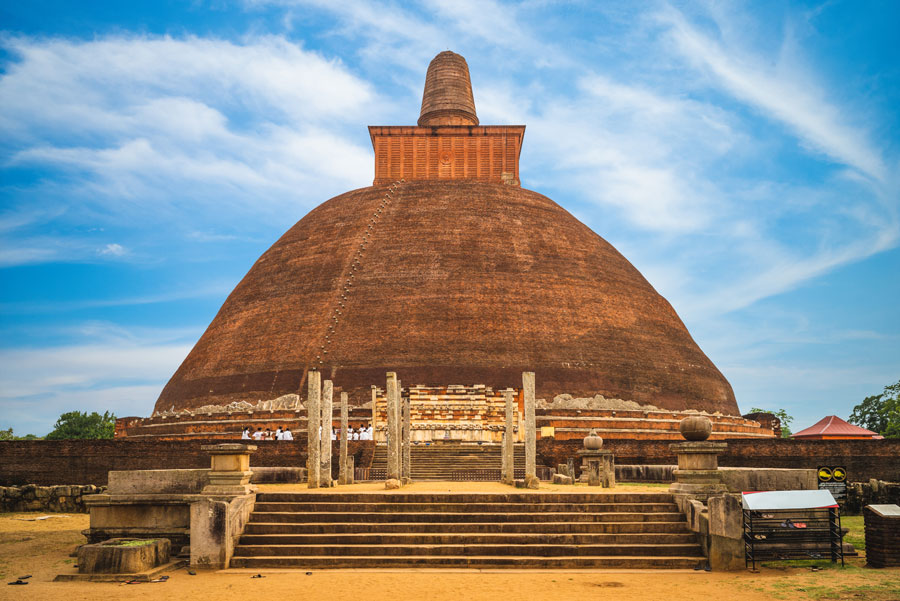
JETAVANARAMA STUPA
The Jetavanarama stupa or Jetavanaramaya is a stupa located in the ruins of Jetavana monastery in the UNESCO world heritage city of Anuradhapura, Sri Lanka. At 122 metres (400 ft), it was the world’s tallest stupa, and the third tallest structure in the world when it was built by King Mahasena of Anuradhapura (273–301). He initiated the construction of the stupa following the destruction of the Mahaviharaya of Anuradhapura. His son Maghavanna I completed the construction of the stupa, and it was renovated by Parakramabahu I of Polonnaruwa. A part of a sash or belt tied by the Buddha is believed to be the relic that is enshrined here.
The structure is significant in the island's history as it represents the tensions within the Theravada and Mahayana sects of Buddhism; it is also significant in recorded history as one of the tallest structures in the ancient world and the tallest non-pyramidal building; the height of the stupa was 122 metres (400 ft), making it the tallest stupa in the ancient world. With the destruction and abandonment of Anuradhapura kingdom in the 11th century, the stupa with others was covered by jungle. King Parakramabahu in 12th century tried to renovate this stupa and it was rebuilt to the current height, a reduction from the original height. Today it stands at 71 metres (233 ft).
The compound covers approximately 5.6 hectares and is estimated to have housed 10,000 Buddhist monks. One side of the stupa is 176 m (576 ft) long, and the flights of stairs at each of the four sides of it are 9 m (28 ft) wide. The doorpost to the shrine, which is situated in the courtyard, is 8 m (27 ft) high. The stupa has a 8.5 m (28 ft) deep foundation, and sits on bedrock.
The structure is no longer the tallest, but it is still the largest, with a base-area of 233,000 m2 (2,508,000 sq ft). Approximately 93.3 million baked bricks were used in its construction; the engineering ingenuity behind the construction of the structure is a significant development in the history of the island.
